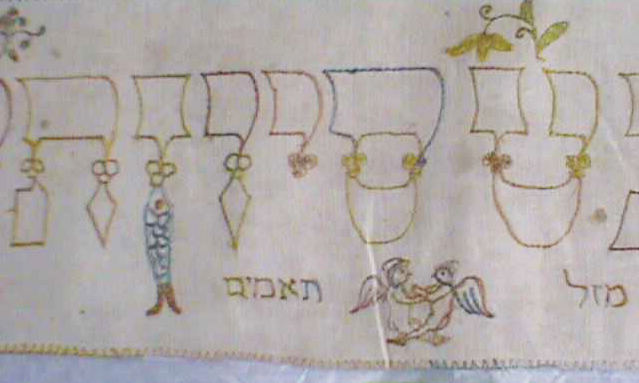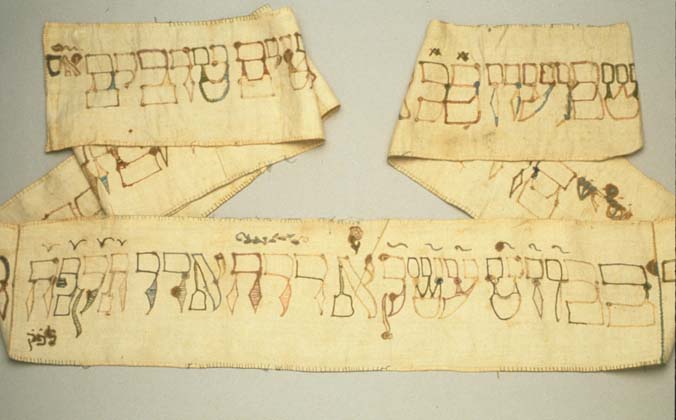The story changed when I began looking into Jewish embroidery traditions. In Judaism, there is a concept called hiddur mitzvah, "beautifying the commandment." This means that it is considered a good thing to make ritual objects more attractive. For example, it is a commandment to a person to wash his hands in a certain way before eating a meal with bread. This involves using a cup to pour water on his hands in a certain sequence. There is technically nothing wrong with using a plain plastic or paper cup to pour the water, but the task comes across as much more appealing if that cup is attractively formed and decorated. A metal worker can make a metal cup with designs stamped on the surface, or a ceramics worker can make a cup on a pottery wheel and glaze it in different colors. Decorating ritual objects emphasizes the joy of the task. Throughout the centuries, hiddur mitzvah has been a source of creativity and livelihood for Jewish professional craftsmen, folk artists, and talented women.
There is an entire world of ritual objects to decorate for the home and the synagogue. I could probably spend the rest of my life making holiday hand towels, challah covers, table cloths, and decorations for my house. Synagogues have traditionally been decorated with ornately embroidered torah mantles, curtains, and other decorations. (I just noticed that at our synagogue's new building, they have gone with a more modern look that emphasizes negative space, and the ark curtain has no embellishment at all.) Often items embroidered for the synagogue made use of fancy gold work and beading, which was the work of professionals. One specific synagogue item, in some communities, was traditionally a piece of folk art made by women--the torah binder.
A torah is a scroll of paper attached to two wooden rods. If left alone, the scroll would quickly unravel from the effort of taking it in and out of the ark and the parchment would crack. In order to keep the scroll rolled tightly, the people reading the torah during services wrap a piece of cloth around the torah to hold it together. Some binders have a buckle, others use velcro (shudder!), while others are long strips of fabric that are wrapped many times around the torah and have their ends tucked in. The task of binding a torah after it is read is considered an honor, in the same category as blessing the torah before reading or lifting it up after reading.
In German Jewish communities, a female relative would save the swaddling cloth used during a baby boy's bris. She would then cut it into strips, sew the strips together, then embroider blessings for the baby with detailed illustrations. The blessings usually contained a variation on the following message:
"May G-d bless this young boy [baby's Hebrew name] son of [father's Hebrew name] and [mother's Hebrew name], born under the good star on the day of [Hebrew birth date]. May G-d raise him to Torah, Chuppah, and the performance of good deeds. Amen forever and ever."
On the baby boy's third birthday, the father would take him to the synagogue. The rabbi would use the embroidered fabric strip to bind the torah in a short ceremony to celebrate the baby's introduction to synagogue participation. The synagogue then kept the torah binder on file as a kind of record of the baby's birth. Ten years later, the boy would use the fabric strip as a torah binder during his bar mitzvah ceremony.
This tradition was mostly limited to German Jews, but now Jews from all communities are discovering it. Some organizations hold workshops on how to create torah binders for different occasions and with a variety of materials. As I learned about this tradition, I knew I wanted to create ones for the children in my family. It was my chance to create something truly personal to each child, a Jewish heirloom that they can always treasure. I also feel like it is a way to connect with these women of the past who created torah binders with their own styles, from rudimentary letters to dazzling needle-painted art.
I have begun my work by gathering the Hebrew names and birth dates for the child recipients. This simple information can inspire a wealth of symbols to illustrate the torah binder:
- The child's name. Some names lend themselves to specific imagery. Examples: Zvi=deer, Devorah=bee, Tamar=date palm.
- The child's zodiac sign. As I learned on a trip to Tzipporah, an archaeological excavation of an Israeli town from the Ancient Roman occupation, zodiac imagery has a long history in Judaism. They are the same symbols, but the names more directly correspond with the image. Example: Sagittarius=archer ("keshet" in Hebrew)
- The father's priestly class. Jews are divided into classes based on whether their ancestors served as Temple priests or assistants. While Judaism is passed through the mother, class is passed through the father. Cohens are the descendants of the high priests of the Temple, while Levis are descendants of the temple assistants. A torah binder might have symbols indicating that a child's father belongs to these classes. For Cohens, the symbol is the hand sign made when they give the priestly benediction. (You might recognize this as Spock's "Live Long and Prosper" hand sign from Star Trek.) The symbol for Levis is a pitcher with water flowing into a bowl.
- Holidays. If a child is born during a holiday, that provides a ready source of symbols. Examples: Matzah for Passover, menorah for Chanukah.
- Torah portion. Jews divide the Torah (Old Testament) into portions, reading one each week through the year. A Torah binder can include imagery from the torah portion read the week of the baby's birth. Examples: A dove with an olive branch for the portion about Noah's ark, a burning bush for the first portion of Exodus.
 |
| Embellishments in this picture include a fish as a reference to "Jonah and the Whale" (for the baby's father's name) and two angels for the zodiac sign Gemini. |
The result is a piece of embroidered art that is completely unique to the child. (Theoretically. I will need to work out what to do to individualize the ones I will make for a set of twins . . .)
Right now, I am still full of questions. How can I sew the long strip of fabric so that I don't go insane from all the hemming required? What is the best transfer technique for getting my pattern onto the fabric? Will I be able to finish one binder before my baby relatives graduate medical school? Join me next time as I attempt to solve these questions.
[The pictures used in this post come from a Flickr set put out by the Magnes Collection of Jewish Art and Life at UC-Berkley.]
[The pictures used in this post come from a Flickr set put out by the Magnes Collection of Jewish Art and Life at UC-Berkley.]


Fascinating!
ReplyDeleteHey Everybody,
ReplyDeleteBelow are the most recommended Bitcoin exchangers (BTC for CASH):
Coinbase: $1 minimum trade
CoinMama
Get free bitcoins with the best Bitcoin faucet rotator:
Bitcoin Faucet Rotator